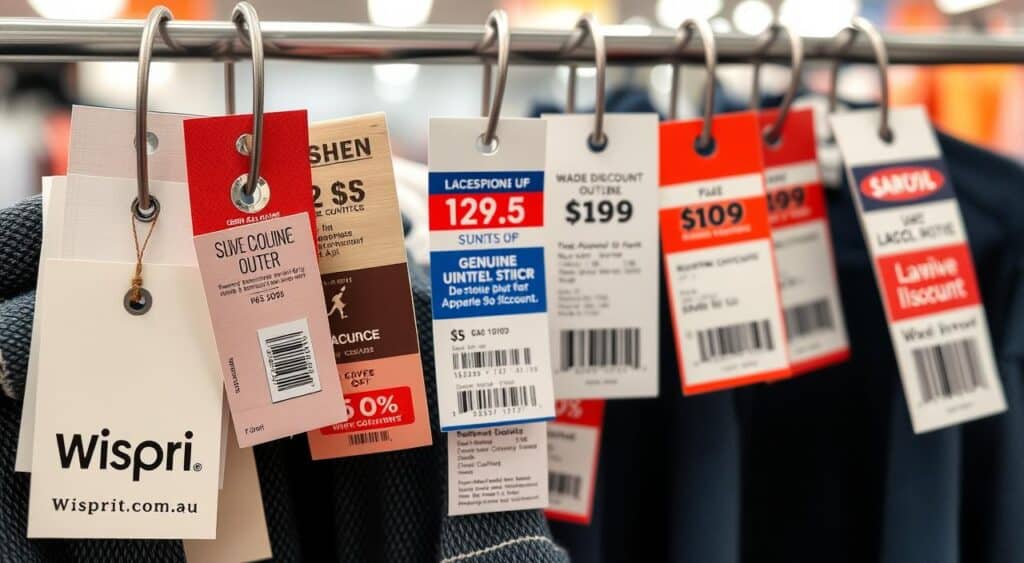Did you know Aussie shoppers lose roughly $1,200 each year by missing the best purchase timing? Or that 73% of online “sales” don’t actually slash prices from their regular cost? Bargain hunting isn’t as straightforward as it seems – especially when browsing those bustling retail parks filled with tempting offers.
Many bargain hunters assume they’re snagging premium products at slashed prices. But here’s the kicker: some brands now create separate product lines specifically for these locations. While you’ll still find authentic clearance deals, a growing number of items are designed differently from their full-price counterparts.
This doesn’t mean you should avoid these shopping hotspots. Platforms like Wispri – Australia’s top price-tracking tool – help savvy buyers spot real discounts. By monitoring price histories across retailers, it alerts users when products hit their target price, cutting through the noise of fake promotions.
The trick lies in knowing what you’re getting. Are you buying last season’s leftovers or a budget-friendly version? Learning this distinction helps you maximise savings without compromising on quality. We’ll show you how to spot the difference like a pro.
Key Takeaways
- Some brands create cheaper product lines specifically for bargain retail locations
- Not all “discounted” items were ever sold at full price originally
- Price-tracking tools help identify genuine sales versus marketing tricks
- Quality standards may differ between regular and outlet-range products
- Successful bargain hunting requires checking product codes and materials
- Historical price data prevents overspending on inflated “discounts”
Understanding the Outlet Shopping Landscape
Navigating Australia’s retail parks can feel like deciphering a treasure map – if you know where to dig. Bargain hunters often assume every item carries deep discounts, but the reality has more layers. Let’s unpack what truly happens behind those “70% off” signs.
What Makes These Locations Unique?
These shopping hubs mix discounted goods with full-priced items under one roof. True bargain sections stock last season’s Levi’s jeans or Lululemon gear that didn’t sell elsewhere. Other areas feature products designed exclusively for these centres, like Nike sneakers with simpler stitching.
Four Main Categories to Know
Not all sections operate the same way. Use this guide to spot differences:
| Type | What’s Sold | Examples | Savings Potential |
|---|---|---|---|
| True Outlet | Past-season stock | The Children’s Place | 30-60% off |
| Factory-Made | Exclusive designs | Banana Republic | 20-50% off |
| Full-Price Retail | Current collections | Sunglasses Hut | 0% discount |
| Refurbished | Repaired electronics | Bose speakers | 40-70% off |
Electronics corners often surprise shoppers. Refurbished Nikon cameras or Toshiba laptops get professional repairs before resale. Always check warranty details here.
Spaces with food courts and play areas keep families browsing longer. While enjoyable, remember – not every “deal” deserves your wallet’s attention.
Outlet Store Secrets: Uncovering Genuine Discounts
Smart shoppers know that genuine bargains hide in plain sight – if you know where to look. Brands often use subtle clues to distinguish their specially-made products from regular stock. Let’s crack the code together.

How to Identify Made-for-Outlet Items
Check clothing tags like a detective. Many brands use symbols to mark outlet-specific items. Banana Republic adds three tiny diamonds under its logo, while GAP outlets use three squares. J Crew’s two-diamond tag tells you it’s factory-made.
| Brand | Outlet Indicator | Product Type |
|---|---|---|
| Banana Republic | Three diamonds below logo | Clothing |
| GAP | Three squares on tag | Apparel |
| Kate Spade | Hollow spade in square | Handbags |
| Coach | “F” in serial number | Accessories |
Recognising Indicators of Quality vs. Knockoffs
Run your fingers over fabrics. Outlet-specific merchandise often uses lighter materials with simpler stitching. A Coach bag might have fewer interior pockets, while Kate Spade’s outlet line uses less hardware detailing.
Comparing Tags & Labels: A Shopper’s Guide
Snap photos of suspicious tags and Google them mid-aisle. Many brands publicly share how their outlet tags differ. Found a handbag with that hollow spade symbol? You’ve spotted Kate Spade’s outlet range. Serial numbers with an “F”? That’s Coach’s factory code.
Remember: These items aren’t necessarily lower quality – they’re just built to hit specific price points. Your job? Decide if the trade-offs match the discounts offered.
Leveraging Price Tracking with Wispri
Imagine having a personal assistant alerting you the moment prices drop. That’s exactly what Wispri brings to bargain hunting – minus the coffee runs. This Aussie-built tool acts as your 24/7 deal detector, scanning prices across major retailers while you focus on life.
![]()
How Wispri Puts Cash Back in Your Pocket
The platform tracks prices at Amazon Australia, JB Hi-Fi, and 15+ other stores simultaneously. Set your target price for that new drill or winter coat, and Wispri’s AI does the heavy lifting. When retailers play musical chairs with discounts, you’ll get notified before the music stops.
Smart Alerts That Work While You Sleep
Wispri’s AI-powered system learns seasonal deals patterns and false sales tactics. Unlike basic trackers, it filters out inflated “was/now” pricing tricks. Found a lounge suite at an outlet? Check its 12-month price history instantly to verify if it’s truly discounted.
Serious savers upgrade to Wispri PRO for advanced features like competitor price matching. The free version still outperforms manual checks – one user saved $412 on a Bunnings shed by waiting for their custom alert.
Whether comparing outlet offers or online prices, this tool helps you spend money wisely. As one Melbourne shopper noted: “It’s like having X-ray vision for hidden savings.”
Smart Strategies for Outlet Shopping Success
Timing is everything when hunting for bargains – your schedule could mean the difference between scoring a steal or battling crowds for leftovers. Savvy Aussie shoppers plan their retail adventures like military operations, combining calendar smarts with digital tools.

Timing Your Visits for Maximum Savings
Swap weekend madness for Tuesday-Thursday excursions. Mid-week trips mean clearer aisles and staff with more time to help. One Melbourne regular shares: “I found last season’s Country Road coats at 60% off on a Wednesday morning – sizes intact.”
Plan visits during autumn or winter for cooler weather and quieter complexes. Coastal locations see smaller crowds outside summer holidays. Early birds get more than worms – arriving at opening time secures prime parking and fresh stock.
Utilising Newsletters and In-store Coupons
Your inbox holds golden tickets. Sign up for brand emails and mall newsletters – they often send VIP passes for extra discounts. Combine these with existing promotions for stacked savings.
Three ways to boost your coupon game:
- Check customer service desks for coupon booklets
- Scan QR codes displayed near store entrances
- Use mall apps for digital-only offers
Saturday sales still draw big crowds, but armed with pre-planned discounts, you’ll outsmart casual browsers. As one Sydney shopper puts it: “My 20% newsletter code turned a good deal into an unbelievable steal.”
Avoiding Common Pitfalls at Outlet Malls
Those tempting red tags might not tell the whole story. Savvy shoppers stay sharp by understanding hidden rules that govern these shopping hubs. Let’s explore how to dodge common mistakes that trip up even experienced bargain hunters.
Decoding Return Rules and Location Differences
Always confirm prices with staff before paying. One Brisbane shopper discovered her $89 dress rang up at $59 – the sticker hadn’t been updated. “It pays to ask,” she notes. This simple check takes seconds but could save dollars.
Return policies vary wildly between locations. While some chains accept exchanges nationwide, others require items to go back to the original outlet. A Sydney family learned this the hard way after driving 90 minutes to return jeans bought on holiday.
Three key differences to watch:
- Many outlet-specific products can’t be returned to regular stores
- Electronics often have shorter warranty periods
- Final sale items usually can’t be exchanged
Online outlets like GAP Factory offer similar deals with easier returns. Their free post-back service beats driving to distant malls. Still, check if web prices match physical locations – sometimes they don’t.
Head straight to the customer service desk first. Their coupon books often contain hidden gems like 20% off first purchases. As one Gold Coast regular advises: “Grab the discounts before you shop – they’re useless after checkout.”
Remember: The deepest discounts often apply to slow-moving stock. That stunning coat in July? It’s likely winter clearance, not a pricing error. Pair this knowledge with digital tools like Wispri to separate true bargains from clever marketing.
Conclusion
Smart shopping isn’t about luck – it’s about making informed choices. With the right tools and knowledge, you can confidently navigate retail parks knowing exactly what’s in your basket. Platforms like Wispri turn guesswork into strategy by revealing price histories across both online and physical locations.
Remember to check product codes and materials before buying. Those outlet ranges might suit your needs perfectly, but understanding their origins helps avoid buyer’s remorse. Pair this awareness with price alerts to strike when genuine discounts appear.
Australian bargain hunters now have an edge. By combining hands-on checks with digital tracking, you keep more money in your pocket without sacrificing quality. Whether hunting for appliances or apparel, this approach transforms how you shop.
Your next outing could be your most rewarding yet. With these strategies, every purchase becomes a win – for your wardrobe and your wallet.

